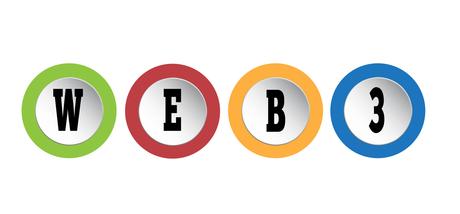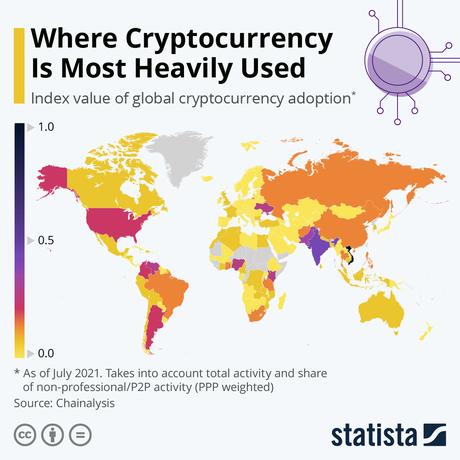 Some consider it the next generation of the internet: Web3 which a decentralized version of the web based on the blockchain. Web3 – sometimes misleadingly called Web 3.0 has overtaken the Internet of Things, aka Industry 4.0, in reporting. Podcasters, investors or analysts, everyone seems to talk about Web3. And Elon Musk tweeted in December 2021, wondering what the future of Web3 might be like 10, 20 or 30 years from now. So let’s dive deeper into it to learn what exactly is behind it, which use cases already exist and why skeptics doubt that the Internet will become more democratic as a result. Also, we will take a look onto some Web3 stocks to buy.
Some consider it the next generation of the internet: Web3 which a decentralized version of the web based on the blockchain. Web3 – sometimes misleadingly called Web 3.0 has overtaken the Internet of Things, aka Industry 4.0, in reporting. Podcasters, investors or analysts, everyone seems to talk about Web3. And Elon Musk tweeted in December 2021, wondering what the future of Web3 might be like 10, 20 or 30 years from now. So let’s dive deeper into it to learn what exactly is behind it, which use cases already exist and why skeptics doubt that the Internet will become more democratic as a result. Also, we will take a look onto some Web3 stocks to buy.
How does Web3 work?
Those who belong to persons who use or own crypto money according to the Statista Global Consumer Survey have an advantage when it comes to Web3. Anyone who has at least an idea of how the blockchain works should feel right at home within of Web3.

Using blockchain technology, Web3 should once again become decentralized and non-hierarchical – unlike now, when most requests on the Internet run through server farms of large tech companies. In Web3, these centralized servers are to be replaced by the blockchain.
Maybe that’s why so many people talking about Web3, and maybe that’s also the reason why it seems to boom and why venture capital firms have put around $33 billion in crypto-related projects in 2021.
Is it Web 3.0 or Web3?
A few years ago there was a lot of talk about Web 3.0: the focus was on semantics, which is why it was also called the “semantic web“. From 2001 onwards there have been annual academic conferences on this. In the concept of a machine-readable web, the information created by users is provided with descriptions that are clear in their meaning, and can therefore be processed by computers. In contrast to Web 3.0, the version of the Internet that is based on public blockchains and is characterized by decentralization and a token-based economy is called “Web3”. But don’t get confused: The word Web 3.0 is also often used for the “new” web.
The term Web3 was established by Gavin Wood in 2014. Wood had then started developing Ethereum as an improvement of the blockchain idea. The Ethereum co-founder has since created the Web3 Foundation, with which he supports decentralized technology projects. But another person, Packy McCormic who is an investor, helped to popularize the Web3. He was also the one who defined it as following: “…the internet owned by the builders and users, orchestrated with tokens.”
What’s new on Web3?
While Web 1.0 was characterized by static websites connected by hyperlinks and easy retrieval of information, Web 2.0 from around 2004/2005 offered social networks, blogs and videos with an interaction feature – which can be seen, for example, in the success of platforms such as Facebook, TikTok & Co. While Web 2.0 continues to this day and is integrated into many areas of life and work, the possibility of digital ownership based on blockchain and crypto assets is to follow with Web3 in the future. In other words, Web3 (at least that’s the idea) will replace these centralized platforms with open protocols and community-run networks.
Summarized, the Web3 is characterized by the key points “Read”, “Write” and (new) “Own”, and it’s about to bring the power and ownership towards creators and users. But similar to the transition from 1.0 to 2.0, the transition to 2.0 to 3 should also be smooth.
Advantages of Web3
Centralized platforms like Apple, Google and Facebook turn user data into money. In a decentralized Web3, users can
- Get more control over their data
- Exchange data with other websites at own discretion thanks to interoperability
- Monetize their data and information by transferring it to companies in exchange for micropayments in cryptocurrency. One of often-cited examples is the video game Axie Infinity which I already mentioned in my article about GameFi. Playing Axie Infinity, players are rewarded with real money for achieving in-game stuff.
SIGN UP FOR UPDATES: SUBSCRIBE!
Are there already Web3 application examples?
The application examples should be familiar to crypto fans. On the one hand, this includes blockchain-based cryptocurrencies such as Bitcoin or Ether. Their principle: Thanks to the blockchain, financial transactions can be carried out without being dependent on banks or state authorities.
Another application example is NFTs. A non-fungible token is a digital certificate of authenticity or ownership, with ownership recorded on the blockchain. These can be digital works of art such as Beeple’s “Everydays – The First 5000 Days”, which was auctioned off at Christie’s for 69 million US dollars, or objects in video games. Ex-boxing world champion Wladimir Klitschko wants to raise money for Ukraine with NFTs.
But you can also make crypto money by allowing other devices to get access to your own WiFi as the Helium network is already showing us that such a concept is possible.
What is the basis of Web3?
The idea of Web3 does not work without so-called DAOs: The Decentralized Autonomous Organizations (DAO) are cornerstones of Web3. Their mission: They want to revolutionize the Internet. On the one hand, DAOs are similar to companies in that they
- Organize people for a mission
- Create wealth
- Solve social problems
But the advantage of DAOs and the differences in contrast to companies are:
- DAOs have no official leadership
- They are community oriented
- The members have a common economic interest
Most importantly, all important decisions are put to the vote on the blockchain. ”In short: DAOs merge the old idea with a completely decentralized, technology-driven approach.
Are there also disadvantages of the Web3?
- The blockchain, on which Web3 is supposed to be based and which is supposed to make it more decentralized and democratic, is an expensive pleasure. It requires investments that the big tech companies probably first can do. No wonder that not only crypto enthusiasts, but also large tech companies and venture capital firms are now interested in the idea of Web3. With their power, they could make themselves the new middlepersons and with thus, ruin the concept of Web3.
- So-called gas fees are due for every transaction on the blockchain.
- There is always someone who has more money, more traditional power or both to consolidate the own position also in the Web3. And that would be the end of the enthusiasm for the decentralized crypto world.
- Others believe it’s an undesirable vision of a pay-to-play internet, in which you have to pay for every activity and social interaction.
- Some skeptics also think that the technical part of Web3 doesn’t make sense because blockchains are significantly slower than standard technology we are using right now. That would lead to the problem that the most popular blockchains wouldn’t be able to deal with the daily amount of data that such platforms like YouTube, Netflix, Uber, Facebook & Co are generating. So to make this whole Web3 thing performant, they point out that there is a centralized service necessary. But a centralized service would destroy the concept of decentralization and with this the whole purpose of Web3.
- Another disadvantage which also seems plausible it that skeptics believe that decentralized systems are making things more complicated and difficult. Too much human power is bound in software projects. In a decentralized world, they point out, making of software should require less effort to unfold the advantages of Web3.
- At this moment crypto tokens are not really regulated, and they exist in a regulatory gray zone. Some regulators, especially in the USA, arguing that crypto tokens are should be treated as securities. Once this happens, a lot of start-ups would probably need to shut down, change the products or move to a different country.
What’s the future like to be?
For now, Web3 is still too theoretical, and it will take some time to see if it comes to fruition. But although Web3 is just beginning to shape, a lot of people are already thinking ahead: It’s logical that Web3 should be followed by Web 4.0 – and that means artificial intelligence (AI). In the future, the Internet could be characterized by intelligent assistants that independently search for information for users. The whole thing is also known under the name “Web OS – Web Operating System”. WebOS should work like the human brain, i.e. like a huge network of extremely intelligent connections.
Web3 stocks to buy
Anyway, if you’re asking yourself which Web3 stocks to buy, I’ve got a selection of Web3 stocks you can analyze:
- Nvidia (NVDA) – Through Nvidia’s hardware, crypto miners provide the technical contributions to keep the blockchain running
- Advanced Micro Devices (AMD) – Processors…yeah. Where would we be without them?
- IBM (IBM) – In past few years, IBM was a pain in the ass. But Big Blue’s artificial intelligence project brings hugely positive implications for Web3 stocks. By bringing more functions to AI and machine learning protocols, IBM can exponentially advance the next generation of internet connectivity.
- Fastly (FSLY) – Fastly provides a content delivery network (CDN). That’s why your favorite website works so well almost everywhere you go. So CDN represents in a certain kind a decentralized infrastructure. And yes, they are still under a centralized system. But as gas fee is one of the disadvantages of decentralized systems (at least right now), a centralized CDN seems to be a practical approach until a better solution is developed.
- Coinbase (COIN) – If Web3 stocks shall be the future, Coinbase is worth to be on a watchlist.
- TE Connectivity (TEL) – TE Connectivity is particularly important for the 5G rollout as this company provides the physical backbone of connectivity solutions.
- Unity Software (U) – Not just a graphics engine with advanced physics modeling in video games but also manager of content steaming, payments, subscriptions, and so on. Or according to Unity CEO John Riccitiello in the 2021 February’s fourth-quarter earnings call: “We are making the tools for creation, for operation. We will bring them around to support, firstly, every metaverse or Web3 application type you can imagine.”
- Warner Music Group (WMG) – CEO Steve Cooper said on the Q1 earnings call in February 2022: “As the global entertainment economy continues to change at light speed, major music companies, they’re the only ones with the skill sets, the global footprint, and the financial resources to fully support artists and songwriters.” In other words: Warner Music is exploring many different approaches toward selling music and protecting copyrights in the emerging Web3 market.
- Block (SQ) – Formerly known as Square, Block is the fintech with an amazing ecosystem providing solutions for point of sale (PoS), P2P payments and cryptocurrency. Its development of Web3 that ensures data security and privacy should continue to provide growth of this company.
